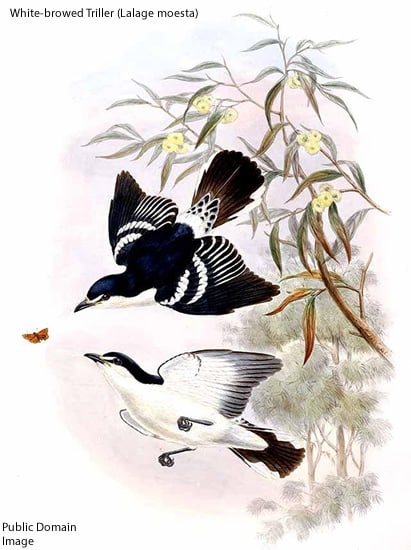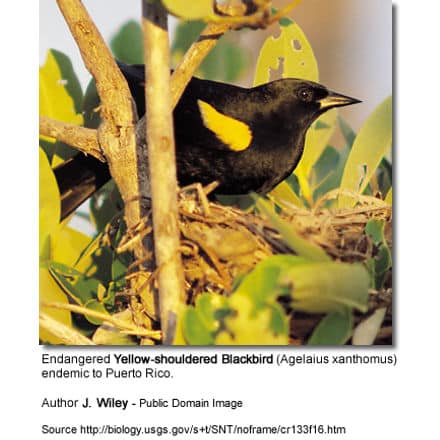Do Bowerbirds Mate for Life?
Ailuroedus, better known as catbirds are the only species of bowerbirds that mate for life. All other species of bowerbirds will mate with as many different mates as they can.
This leads to the females of all the other species of bowerbirds, other than ailuroedus, raising their young on their own.
Since catbirds do mate for life, both the males and females play a role in parenting their young.
It’s also interesting to note that even though the Papuan and Australian birds are of the same species, the Australian bowerbirds will lay from one to three eggs per season, while the Papuan bowerbirds lay only one egg per season.
How Do Bowerbirds Attract a Mate?
What makes bowerbirds special in the bird world is their unique courtship ritual.
Like the peacock, bowerbirds must impress the female in order to successfully mate and produce offspring.
This is done through some “mechanical engineering” that can take months to pull off along with some bright decorating ideas. And maybe even a little illusion.
Male bowerbirds demonstrate to their potential mates how special they are by building a U-shaped chute (bower) made of twigs, then decorating their interiors and entrances with all sorts of stones, shells, fruits, and even discarded bottle caps and bits of plastic depending on the species of bird.
Each species has its own highly prized way of interior decorating. Some like all fruit, and some like a lot of discarded man-made materials.
But the common denominator is they all use objects to decorate the interiors and exteriors of their bowers in the hope of attracting a suitable mate.
Anything bright and shiny helps attract the female’s attention. Colors also play an important role for female bowerbirds. Each female has their own personal choices as to what sort of decorations attract her best.
Once the male has successfully built his “castle”, he then “dances” in front of the entrance to grab even more attention.
He’ll run back and forth in front of his bower while making loud calls and raising their feathers on end. Anything to say “Pick Me!”.
However recent scientific research shows that the female is basing their decisions on a host of qualities with younger females seeming to be more attracted to colors than older females who prefer the overall courtship display.
The Garden of Bowerbirds
Some male bowerbirds have learned once they have their bowers completed, there are other ways to help improve their success in attracting a mate.
Every bird must eat, so why not a house with a garden included?
New research has shown that spotted bowerbirds in Australia use bush tomatoes to decorate their structures. This is important because no other animal species is known to actually cultivate plants for other reasons than for food.
Yet the male spotted bowerbirds are literally growing gardens of bush tomatoes which they use to decorate the interiors and exteriors of their homes to help attract mates.
Whether this is intentional or not is still up to further study.
What we do know is that these Australian bowerbirds are using bush tomato fruit to decorate their home’s interior, not to eat them. In fact, when the fruit loses it color it’s tossed away, which leads to new plants being cultivated.
The important aspect of all of this is the male’s never eat the fruit. Scientists have proved this by looking through the bird’s droppings. None were found to contain the fruit’s seeds.
Studies on the male spotted bowerbird have proven that the more fruit a male can show off to the female, the more often he will successfully mate.
Joah Madden, the person who discovered this behavior, says that when the birds begin building their bowers, there will be few bush tomato plants around. But by the next year, the plant’s number dramatically increased.
And since bowerbirds can continue using their bowers for ten years or more, it would pay off in the long run for the birds to grow the fruit close by, thus adorning their homes with more fruit demonstrating to the female how amazing he can really be.
Why Do Bowerbirds Build Bowers?
The bowerbird species that do build bowers do so in order to attract a mate in a complex mating ritual that includes building structures or arranging items in a pleasant way to grab the female’s attention the way a peacock uses its feathers and displays of affection.
But not all bowerbirds build bowers, even though that’s where their name comes from.
Nor are all bowers the same.
Each genius, eight in total, of bowerbirds has its own unique way of either building or arranging the different objects and elements they find in their environment in order to attract a mate.
There are three primary structures males build.
The first is the famous “U” shaped bower that has attracted attention from scientists and birders alike.
These bowers are created using sticks in rows to create an “avenue” or safe space for the female to look at and can be up to six feet tall. Similar hut-like structures can be as wide as twelve feet.
These bowers may be further decorated with everything from leaves to litter. Some walls are even painted by the males using berry juice. Others are adorned with fruits and other plant matter.
Other species prefer to create a “court” that acts as a sort of stage for the bowerbird to perform his dance, part of the entire mating ritual.
These display courts usually contain everything from shells, stones bits of plastic, and other colorful garbage that the male gathers or steals from other competing male’s bowers.
The third type of bower is the maypole structure. These towers can reach heights many feet tall and are constructed using a tree sapling as the main foundation and various plant matter packed around the sapling.
Male bowerbirds can take months to build their structures. Some structures are used year after year, some having been maintained for 30 years, while others are abandoned after one use.
Are Bowers Nests?
No, bowers are not nests. They are used by the male for courtship only. Once the pair copulate, the female either leaves or is chased away by the male.
Once the female leaves she will find a place to make her nest where she will lay either one or up to three eggs depending on the species of bird.
The male, after successfully mating, will spruce up his bower and wait until the next female drops by and will again go through the mating ritual in order to attract yet another mate.
Only one species of bowerbird, ailuroedus, mates for life and helps raise their young together.
For the rest of the females, after incubation it’s all on the female to build her nest and rear her chicks on her own.
In Closing
Male bowerbirds spend a lot of time and energy building elaborate structures and performing complicated courting rituals all in the hopes of finding a mate.
For one species this courtship leads to a lifelong “marriage”, and for the rest a place to court as many females as possible.
Regardless if the birds are monogamous or not, they are definitely interesting birds to study and get to know.
Perhaps by studying these birds’ mating behaviors, males of the homo sapiens species can pick up a few tips to improve their chances of finding a mate.




